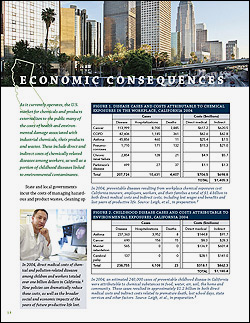Berkeleyan
'Green chemistry' promoted as a sustainable approach to managing the manufacture and use of toxics
Chemical exposures cost California an estimated $2.6 billion, says new policy report endorsed by 127 UC faculty
![]()
| 30 January 2008
Serious gaps in existing laws regulating the production and use of hazardous chemicals fail to protect public health and the environment, according to a report released earlier this month by researchers at Berkeley and UCLA. As a result of this inadequate oversight, chemical- and pollution-related diseases among children and workers in California cost the state's insurers, businesses, and families an estimated $2.6 billion in direct and indirect costs, says the report, which includes a set of recommended policy reforms for the state.
In 2004, more than 200,000 California workers were diagnosed with deadly, chronic diseases - such as cancer or emphysema - attributable to chemical exposures in the workplace, according to the report. Another 4,400 died from those diseases. The new findings, based upon well-established methodology for analyzing economic impact, indicate that those diseases resulted in $1.4 billion in both direct medical costs and indirect costs that include lost wages and benefits.
 |
An additional $1.2 billion in direct and indirect costs is attributed to 240,000 cases of preventable childhood diseases in California related to environmental exposure to chemical substances, the report says.
The existing problems and recommended policy changes are detailed in the report, "Green Chemistry: Cornerstone to a Sustainable California," which has been endorsed by 127 faculty members from seven UC campuses, Lawrence Berkeley National Laboratory, and Lawrence Liver-more National Laboratory.
The California Environmental Protection Agency commissioned the Centers for Occupational and Environmental Health (COEH) at Berkeley and UCLA to prepare the report. COEH is a multi-disciplinary research program based at the UC campuses of Berkeley, Davis, San Francisco, Irvine, and Los Angeles. Additional funding for the report came from the UC Office of the President, the National Institute for Occupational Safety and Health and the U.S. Centers for Disease Control and Prevention.
"This report, for the first time, puts cost estimates on the consequences for Californians of current chemical- and product-management policies," says John Balmes, a Berkeley professor of environmental health sciences (and a UCSF professor of medicine) who directs the COEH effort at UC's Northern California campuses. "California has shown that creating new jobs and investment opportunities can go hand in hand with protecting human health and the environment. We have been doing this with vehicle emissions and energy use, and this new report makes it obvious that we will need to do the same with chemicals and products."
The report presents data from the state's Department of Toxic Substances Control showing that 61 of the state's 85 largest hazardous-waste sites are leaking toxic material directly into groundwater. In addition, an estimated 1 million California women of reproductive age have blood-mercury levels that exceed what the U.S. EPA considers safe for fetal development, and biomonitoring studies have detected more than 100 synthetic chemicals and pollutants in breast milk, umbilical-cord blood, and other bodily fluids and tissues, the report says.
With global chemical production predicted to increase 330 percent by 2050, health problems related to environmental contamination are likely to grow unless comprehensive steps are taken now, say the authors, who assert that green chemistry - the use of renewable and safer raw materials, manufacturing processes, and products - offers a sustainable solution.
The report calls on California to lead the nation in implementing a comprehensive approach to the management of chemicals and products. Policy recommendations include passing new laws to remedy the insufficient data available on the toxicity of chemicals so California businesses, regulators, and consumers can make informed choices about the products they use; providing California agencies with a new legal framework to enable them to act when there are reasonable concerns about a product's safety, even when complete hazard or tracking data are unavailable; and investing in the design of chemicals, materials, and manufacturing processes that are inherently safer for humans.
Some of these recommendations echo a 2006 UC report to the California Legislature on green-chemistry policy, which contributed to the introduction of new state legislation in 2007 to require improved reporting on the sale of high-quantity chemicals and reductions in some uses of the most toxic chemicals. That legislation is expected to be reintroduced in 2008.
A PDF of the report is available for download at coeh.berkeley.edu/greenchemistry/briefing.

